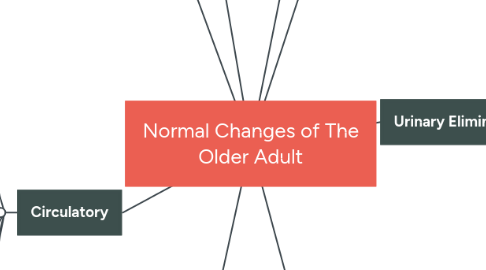
1. Nutrition and Hydration
1.1. Reduced need for calories
1.1.1. Less lean body mass
1.1.2. Decline in BMR
1.1.3. Activity level declines
1.2. Intercellular fluid lost causes decreased total body fluid
1.3. 1,500 mLs of fluid a day minimum
2. Rest and Sleep
2.1. Phase advance
2.2. More time in stages I and II
2.3. Less sound sleep
2.4. Delay in onset of sleep
2.5. Possible sleep disturbances
2.5.1. Insomnia, nocturnal myoclonus, restless leg syndrome, sleep apnea, GERD, dementia, musculoskeletal disorders
3. Sexuality
3.1. Andropause
3.1.1. Does not happen to all men
3.1.2. Breast enlargement
3.1.3. Osteopenia
3.1.4. Osteoporosis
3.1.5. Shrinkage of testes
3.2. Dyspareunia
3.2.1. Result of less lubrication in women
3.3. Erectile dysfunction
3.3.1. Common but not normal
3.4. Menopause
4. Respiratory
4.1. Problems develop easily and are hard to handle
4.2. Changes in upper airway paths, nose, and trachea
4.3. Reduced cough
4.4. Lungs
4.4.1. Reduced in size
4.4.2. Reduced in weight
4.5. Decrease elastic recoil
4.6. Alveoli less elastic
4.7. Vital capacity reduced
4.8. Residual volume increased
4.9. Loose or brittle teeth can be aspired
5. Circulatory
5.1. Heart valves
5.1.1. Thicker
5.1.2. Rigid
5.2. Aorta dilated
5.2.1. Slight ventricular hypertrophy
5.2.2. Left ventricular wall thickened
5.3. Myocardial muscle less efficient
5.3.1. Decreased strength
5.3.2. Decreased CO when demand increases
5.4. Calcification
5.4.1. Reduced elasticity
5.5. Less sensitive to baroreceptor regulation
5.5.1. Blood pressure
6. Urinary Elimination
6.1. Hypertrophy and thickening of bladder muscles
6.1.1. Decreased ability to to expand
6.1.2. Reduced storage capacity
6.1.2.1. Daytime urinary frequency and nocturia
6.2. Changes in cortical control of of micturition
6.2.1. Nocturia
6.3. Inefficient neurological control
6.3.1. Retention of large volumes of urine
6.3.1.1. Females: fecal impaction
6.3.1.2. Males: prostatic hypertrophy
6.4. Kidney filtration ability decreased
6.4.1. Affects drug elimination and could cause adverse effects or toxicity
6.5. Reduced renal function
6.5.1. High BUN and creatinine
6.6. Decreased tubular function
6.6.1. Concentration of urine changes
6.7. Increase renal threshold for glucose
6.8. Incontinence
6.8.1. Not normal aging
7. Reproductive
7.1. Women
7.1.1. Hormonal changes
7.1.2. Vaginal epithelium thins
7.1.3. Atrophy of cervix, uterus, and Fallopian tubes
7.1.4. Vaginal canal changes
7.1.5. Uterus and ovaries decrease in size
7.1.6. Breasts sag
7.1.7. Fallopian tubes become shorter and straighter
7.2. Men
7.2.1. Seminal vesicles
7.2.1.1. Thinner epithelium
7.2.2. Muscle tissues becomes connective tissue
7.2.3. Decreased capacity to retain fluids
7.2.4. Seminiferous tubule changes
7.2.4.1. Increased fibrosis, epithelium thinning, thickening of the basement membrane, and narrowing of the lumen
7.2.5. Atrophy of testes
7.2.6. Enlargement of prostate gland
8. Gastrointestinal
8.1. Atrophy of tongue
8.1.1. Affects taste buds and taste sensation
8.2. Saliva production decreased
8.2.1. Difficulty swallowing
8.3. Presbyesophogus
8.3.1. Weaker esophageal contractions
8.4. Esophageal and stomach motility decreases
8.4.1. Risk for aspiration and indigestion
8.5. Decrease elasticity of stomach
8.6. High pH in stomach
8.6.1. Decline in Hydrochloric acid and pepsin
8.7. Fewer cells on absorbing surface of intestinal wall
8.8. Sensory perception decreases
8.8.1. Constipation or incomplete elimination
8.9. Decreased bile salt synthesis
8.9.1. Increased gallstone development
8.10. Pancreatic changes
8.10.1. Digestion of fats is affected
8.11. Slower peristalsis
8.11.1. Increase risk of constipation
